MAY 2025 - JANUARY 2026
YOU CANNOT SAY GOODBYE TO A MYTH
FOLKERT DE JONG IN DIALOGUE WITH WORKS FROM THE REINKING COLLECTION
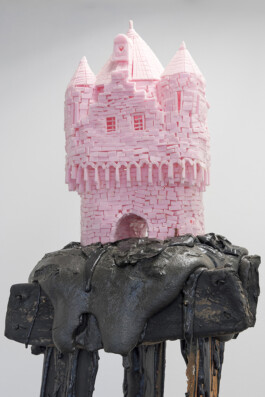


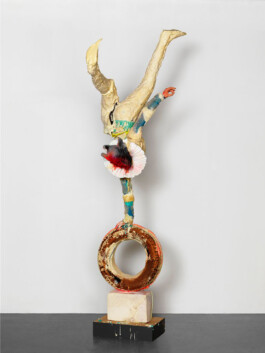
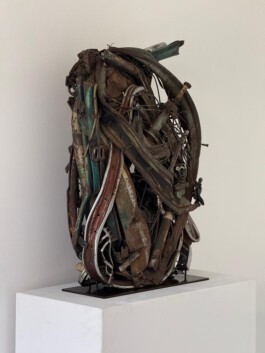

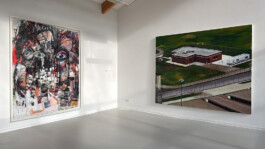
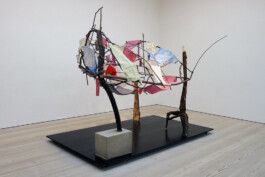
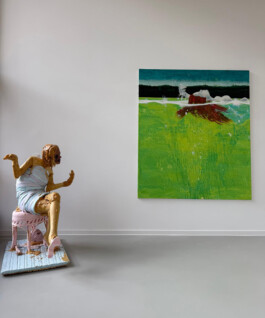
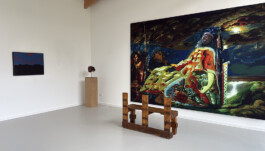
Works by the following artists can be seen:
Steven Allan, Hermine Anthoine, Arman, Joseph Beuys, Alexandra Bircken, Jonathan Borofsky, Michael Buthe, Lawrence Caroll, César, Dinos & Jake Chapman, Mat Collishaw, Henry Coombes, Folkert de Jong, Madeleine Dietz, Felix Droese, Francois Dufrene, Jimmie Durham, Henrik Eiben, Frida Collective, Pachet Fulmen, Barnaby Furnas, Anna Gaskell, Isa Genzken, Till Gerhard, Rodney Graham, Jessica Jackson Hutchins, Son Jongjun, Edward Kienholz, Henning Kles, Douglas Kolk, Josephine Meckseper, Seung Ah Paik, Wolfgang Petrick, Mirko Reisser, Kirstine Roepstorff, Karl-Heinz Rummeny, Reiner Ruthenbeck, Werner Schreib, Markus Selg, Dirk Skreber, Agathe Snow, Daniel Spoerri, Dimitris Tzamouranis, Timm Ulrichs, Ben Vautier, Jacques Villegle, Wolf Vostell, Kelley Walker und Andy Warhol
Plan your visit:
Tickets
What does collecting art actually mean?
It is far more than just accumulating things. It is a deeply human act, an act of connection, driven by curiosity, memory, and the search for meaning. A collection creates resonant spaces in which works of art interact with one another, meanings unfold, and worlds emerge.
"Es weltet!" or "Being in the world"—this is what the philosopher Martin Heidegger calls the fundamental mode of human existence. He emphasizes that subject and world are inextricably linked. Being, therefore, is not mere existence, but the understanding of being.
Works of art are things charged with human experiences and emotions. Engaging with, and especially collecting, art is thus a process in which meaning, time, history, and humanity are condensed. In this sense, engaging with art is not a solitary event, but an event that produces "world" in the best Heideggerian sense.
The exhibition You Cannot Say Goodbye to a Myth invites visitors to experience this opening of the world – through 16 rooms, 16 stations, and 16 moments of engagement with art. It presents a dialogue about the body and history, about memory and myth, about transience and transformation.
At its core is the work of Dutch artist Folkert de Jong (*1972), whose sculptural installations made from such volatile materials as polyurethane foam and Styrofoam are as disturbing as they are fascinating. His works are grotesque, colorful, and almost playful – offering a deep insight into the human abyss of power, violence, and trauma.
De Jong's works demonstrate how collective memory is literally inscribed in the body and how fragile and vulnerable this memory can be at the same time. The choice of fragile materials, not designed to last forever, illustrates the power of experience and history on people.
The exhibition brings de Jong's works into a dialogic relationship with works from the Reinking Collection – a collection characterized by curiosity, openness, and a deep interest in artistic forms of expression. A collection that is not only based on aesthetic choices but unfolds an existential world of images: full of symbols, ruptures, myths, and metaphors. Here, collecting becomes an existential gesture – an attempt to grasp the unspeakable, to touch history, to reflect oneself. In this sense, collecting is also a practice of being human: questioning, searching, remembering.
The relationship between artist Folkert de Jong and collector Rik Reinking is more than a curatorial decision – it is a friendly, lively exchange. Both are united by their interest in the great narratives of humanity, in the cracks and masks of Western civilization, in the question of how art can touch the body, history, and spirit simultaneously. The works in the exhibition therefore do not stand side by side, but enter into a genuine, tense dialogue: between materiality and concept, between seduction and exposure, between past and present.
Each room of this exhibition is a chapter – a space for thought, a field of experience. It is about what remains and what dissolves. About the fleeting, the captured, the transformed. You Cannot Say Goodbye to a Myth – the title says it all. Myths don't disappear. They transform, living on in new images, new readings, new contexts. They are tools of interpretation and power – but also of hope. And they remain part of what defines our cultural identity.
Especially in an age when artificial intelligence generates images, when reality is simulated, and digital surfaces determine our lives, this exhibition should remind us of something fundamental: art is also physical. It has mass, resistance, presence. It challenges us – sensually, emotionally, intellectually. Art creates a space in which the world happens – and in which we can encounter ourselves.
This exhibition is therefore an invitation:
to marvel, to think, to feel. To engage in dialogue with the works, with history, and, ideally, with ourselves.
A ship that will never sail – and yet it invites us on a journey. Brian Griffiths' Beneath the Stride of Giants is a monumental vessel, built from Victorian wardrobes and pieces of furniture that once filled rooms, preserved memories, and concealed stories. Now they are part of a vehicle that needs neither waves nor wind to transport us to other worlds. Like the ark, symbolizing hope and new beginnings, like the ship that Peter Pan travels to Neverland, like the wardrobe portal to Narnia, or the rabbit hole that leads Alice to Wonderland – Griffiths' work evokes the great tales of childhood that oscillate between reality and fantasy. Yet the ship remains in place, anchored in a museum on a hill.
Here, high above the world, the work appears like a homage to the restless, the intrepid, who dream of something greater. It's reminiscent of Fitzcarraldo, who towed his steamship over a mountain, obsessed with the idea of making the impossible possible. Griffiths' ship also embodies this spirit: it rejects function, yet not imagination. It invites us to join him in our thoughts, to where myths are born, where the real and the fantastical meet, where a journey can begin without a single wave breaking.
About the artist:

Inspired by the theatricality of representations of past and future in popular culture and science fiction, Brian Griffiths (*1968) transforms found and technically simple materials into fantastical new objects.
Although Griffiths' works are carefully crafted, he makes no secret of the nature of his materials. The deliberate lack of surface and the ambiguous nature of his constructions allow space to imagine what exactly they might be and the journeys they might take you on.
Since graduating with an MA in Fine Art from Goldsmiths, University of London, in 1996, Griffiths has exhibited extensively in the UK and internationally. He lives and works in London. Beneath the Stride of Giants was originally created for a solo exhibition at the Camden Arts Centre in 2004.
The idea is to reinterpret the world-famous hit We Are the World from 1985 by transforming the original video and sound material with the help of artificial intelligence. Forty years after the song was created, FRIDA replaces the protagonists of the original music video with current political figures. Despots and controversial leaders, notorious for their hate speech, now "sing" together for a better world. A song that once symbolized peace and global unity is now performed by people deeply involved in today's conflicts. This juxtaposition creates a stark contrast between the harmony of the song and the harsh realities of modern geopolitics.
The real twist on this project lies in its foundation: the artificial intelligence-generated voices of these world leaders were trained solely on their publicly documented hate speech. Nearly 5,000 hours of hateful rhetoric were meticulously curated and fed into advanced AI voice software to produce the unexpected result - a song of peace. But that's not all: using cutting-edge image generation tools and AI-driven lip-syncing technology, the accompanying video clip was brought to life, merging technology and irony into a powerful artistic statement.
The satire is to expose the absurdity and double standards of today's political communication.
With the message of solidarity and compassion coming from the mouths of individuals who often incite division and hatred, FRIDA holds a mirror up to world politics. The work shows how far international rhetoric has strayed from the ideals the song originally represented.
Through satirical distortion, FRIDA critically examines today's political discourse and the increasing coarsening of language. By reinterpreting the original, the work takes on a new dimension that raises fundamental questions: How has the tone of international communication evolved? To what extent have hatred and division overshadowed the earlier vision of global solidarity? What if hatred turned into peace?
In order of appearance: Donald Trump, Vladimir Putin, Kim Jong Un, Xi Jinping, Ali Khamenei, Recep Tayyip Erdoğan, Benjamin Netanyahu, Hibatullah Akhundzada, Volodymyr Zelenskyy, Javier Milei, Nicolás Maduro, Jair Bolsonaro, Daniel Ortega, Jean-Luc Mélenchon, Giorgia Meloni, Marine Le Pen and others.
With this work, the artist collective wants to underline the urgency of diplomacy, respectful communication and social cohesion. It is not only a provocative critique of the current political climate, but also a satirical appeal to the responsibility of individuals to use language as a tool for understanding, not division.
FRIDA's work goes beyond mere social critique; it is both a call to action and a hopeful plea for a return to mutual respect and humility in our interactions.
On display for a limited time at the Woods Art Institute, the work unfolds as an immersive narrative. Visitors will embark on a thought-provoking journey, following the evolution from the raw intensity of hate speech to the process of AI training, culminating in the powerful visual and auditory experience of the reimagined song and video clip.
The Reinking collection is pleased to add the video work "We are the World" by the artist collective FRIDA to its collection. In a time of global uncertainty and social upheaval, it is more important than ever for an institution to strengthen the voice of art and to emphasize its role as a space for reflection, dialogue and freedom.
Art not only creates new perspectives, but also defends freedom of thought and expression - the cornerstone of an open society. FRIDA's work consciously uses satire and irony as powerful tools to question social structures, expose contradictions and hold up a mirror to society.
By acquiring "We are the World", the Reinking collection is sending a clear signal about the importance of artistic positions that deal with the challenges of our time in a courageous, astute and multifaceted way.
MAY 2025 - JANUARY 2026
YOU CANNOT SAY GOODBYE TO A MYTH
FOLKERT DE JONG IN DIALOGUE WITH WORKS FROM THE REINKING COLLECTION










What does collecting art actually mean?
It is far more than just accumulating things. It is a deeply human act, an act of connection, driven by curiosity, memory, and the search for meaning. A collection creates resonant spaces in which works of art interact with one another, meanings unfold, and worlds emerge.
"Es weltet!" or "Being in the world"—this is what the philosopher Martin Heidegger calls the fundamental mode of human existence. He emphasizes that subject and world are inextricably linked. Being, therefore, is not mere existence, but the understanding of being.
Works of art are things charged with human experiences and emotions. Engaging with, and especially collecting, art is thus a process in which meaning, time, history, and humanity are condensed. In this sense, engaging with art is not a solitary event, but an event that produces "world" in the best Heideggerian sense.
The exhibition You Cannot Say Goodbye to a Myth invites visitors to experience this opening of the world – through 16 rooms, 16 stations, and 16 moments of engagement with art. It presents a dialogue about the body and history, about memory and myth, about transience and transformation.
At its core is the work of Dutch artist Folkert de Jong (*1972), whose sculptural installations made from such volatile materials as polyurethane foam and Styrofoam are as disturbing as they are fascinating. His works are grotesque, colorful, and almost playful – offering a deep insight into the human abyss of power, violence, and trauma.
De Jong's works demonstrate how collective memory is literally inscribed in the body and how fragile and vulnerable this memory can be at the same time. The choice of fragile materials, not designed to last forever, illustrates the power of experience and history on people.
The exhibition brings de Jong's works into a dialogic relationship with works from the Reinking Collection – a collection characterized by curiosity, openness, and a deep interest in artistic forms of expression. A collection that is not only based on aesthetic choices but unfolds an existential world of images: full of symbols, ruptures, myths, and metaphors. Here, collecting becomes an existential gesture – an attempt to grasp the unspeakable, to touch history, to reflect oneself. In this sense, collecting is also a practice of being human: questioning, searching, remembering.
The relationship between artist Folkert de Jong and collector Rik Reinking is more than a curatorial decision – it is a friendly, lively exchange. Both are united by their interest in the great narratives of humanity, in the cracks and masks of Western civilization, in the question of how art can touch the body, history, and spirit simultaneously. The works in the exhibition therefore do not stand side by side, but enter into a genuine, tense dialogue: between materiality and concept, between seduction and exposure, between past and present.
Each room of this exhibition is a chapter – a space for thought, a field of experience. It is about what remains and what dissolves. About the fleeting, the captured, the transformed. You Cannot Say Goodbye to a Myth – the title says it all. Myths don't disappear. They transform, living on in new images, new readings, new contexts. They are tools of interpretation and power – but also of hope. And they remain part of what defines our cultural identity.
Especially in an age when artificial intelligence generates images, when reality is simulated, and digital surfaces determine our lives, this exhibition should remind us of something fundamental: art is also physical. It has mass, resistance, presence. It challenges us – sensually, emotionally, intellectually. Art creates a space in which the world happens – and in which we can encounter ourselves.
This exhibition is therefore an invitation:
to marvel, to think, to feel. To engage in dialogue with the works, with history, and, ideally, with ourselves.
Works by the following artists can be seen:
Steven Allan, Hermine Anthoine, Arman, Joseph Beuys, Alexandra Bircken, Jonathan Borofsky, Michael Buthe, Lawrence Caroll, César, Dinos & Jake Chapman, Mat Collishaw, Henry Coombes, Folkert de Jong, Madeleine Dietz, Felix Droese, Francois Dufrene, Jimmie Durham, Henrik Eiben, Frida Collective, Pachet Fulmen, Barnaby Furnas, Anna Gaskell, Isa Genzken, Till Gerhard, Rodney Graham, Jessica Jackson Hutchins, Son Jongjun, Edward Kienholz, Henning Kles, Douglas Kolk, Josephine Meckseper, Seung Ah Paik, Wolfgang Petrick, Mirko Reisser, Kirstine Roepstorff, Karl-Heinz Rummeny, Reiner Ruthenbeck, Werner Schreib, Markus Selg, Dirk Skreber, Agathe Snow, Daniel Spoerri, Dimitris Tzamouranis, Timm Ulrichs, Ben Vautier, Jacques Villegle, Wolf Vostell, Kelley Walker und Andy Warhol
Plan your visit:
Tickets
MAY 2025 - JANUARY 2026
BRIAN GRIFFITHS
BENEATH THE STRIDE OF GIANTS
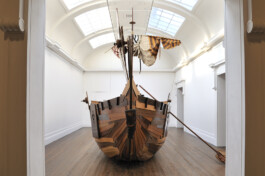

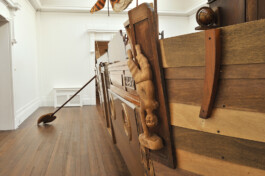
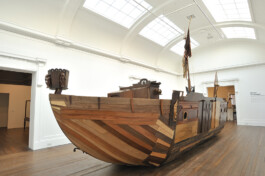

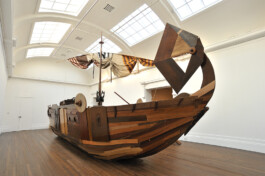
A ship that will never sail – and yet it invites us on a journey. Brian Griffiths' Beneath the Stride of Giants is a monumental vessel, built from Victorian wardrobes and pieces of furniture that once filled rooms, preserved memories, and concealed stories. Now they are part of a vehicle that needs neither waves nor wind to transport us to other worlds. Like the ark, symbolizing hope and new beginnings, like the ship that Peter Pan travels to Neverland, like the wardrobe portal to Narnia, or the rabbit hole that leads Alice to Wonderland – Griffiths' work evokes the great tales of childhood that oscillate between reality and fantasy. Yet the ship remains in place, anchored in a museum on a hill.
Here, high above the world, the work appears like a homage to the restless, the intrepid, who dream of something greater. It's reminiscent of Fitzcarraldo, who towed his steamship over a mountain, obsessed with the idea of making the impossible possible. Griffiths' ship also embodies this spirit: it rejects function, yet not imagination. It invites us to join him in our thoughts, to where myths are born, where the real and the fantastical meet, where a journey can begin without a single wave breaking.
About the artist:

Inspired by the theatricality of representations of past and future in popular culture and science fiction, Brian Griffiths (*1968) transforms found and technically simple materials into fantastical new objects.
Although Griffiths' works are carefully crafted, he makes no secret of the nature of his materials. The deliberate lack of surface and the ambiguous nature of his constructions allow space to imagine what exactly they might be and the journeys they might take you on.
Since graduating with an MA in Fine Art from Goldsmiths, University of London, in 1996, Griffiths has exhibited extensively in the UK and internationally. He lives and works in London. Beneath the Stride of Giants was originally created for a solo exhibition at the Camden Arts Centre in 2004.
Plan your visit:
Tickets
MAY 2025 - JANUARY 2026
FRIDA COLLECTIVE
WE ARE THE WORLD (?)







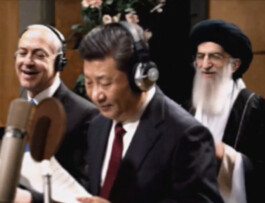
The idea is to reinterpret the world-famous hit We Are the World from 1985 by transforming the original video and sound material with the help of artificial intelligence. Forty years after the song was created, FRIDA replaces the protagonists of the original music video with current political figures. Despots and controversial leaders, notorious for their hate speech, now "sing" together for a better world. A song that once symbolized peace and global unity is now performed by people deeply involved in today's conflicts. This juxtaposition creates a stark contrast between the harmony of the song and the harsh realities of modern geopolitics.
The real twist on this project lies in its foundation: the artificial intelligence-generated voices of these world leaders were trained solely on their publicly documented hate speech. Nearly 5,000 hours of hateful rhetoric were meticulously curated and fed into advanced AI voice software to produce the unexpected result - a song of peace. But that's not all: using cutting-edge image generation tools and AI-driven lip-syncing technology, the accompanying video clip was brought to life, merging technology and irony into a powerful artistic statement.
The satire is to expose the absurdity and double standards of today's political communication.
With the message of solidarity and compassion coming from the mouths of individuals who often incite division and hatred, FRIDA holds a mirror up to world politics. The work shows how far international rhetoric has strayed from the ideals the song originally represented.
Through satirical distortion, FRIDA critically examines today's political discourse and the increasing coarsening of language. By reinterpreting the original, the work takes on a new dimension that raises fundamental questions: How has the tone of international communication evolved? To what extent have hatred and division overshadowed the earlier vision of global solidarity? What if hatred turned into peace?
In order of appearance: Donald Trump, Vladimir Putin, Kim Jong Un, Xi Jinping, Ali Khamenei, Recep Tayyip Erdoğan, Benjamin Netanyahu, Hibatullah Akhundzada, Volodymyr Zelenskyy, Javier Milei, Nicolás Maduro, Jair Bolsonaro, Daniel Ortega, Jean-Luc Mélenchon, Giorgia Meloni, Marine Le Pen and others.
With this work, the artist collective wants to underline the urgency of diplomacy, respectful communication and social cohesion. It is not only a provocative critique of the current political climate, but also a satirical appeal to the responsibility of individuals to use language as a tool for understanding, not division.
FRIDA's work goes beyond mere social critique; it is both a call to action and a hopeful plea for a return to mutual respect and humility in our interactions.
On display for a limited time at the Woods Art Institute, the work unfolds as an immersive narrative. Visitors will embark on a thought-provoking journey, following the evolution from the raw intensity of hate speech to the process of AI training, culminating in the powerful visual and auditory experience of the reimagined song and video clip.
The Reinking collection is pleased to add the video work "We are the World" by the artist collective FRIDA to its collection. In a time of global uncertainty and social upheaval, it is more important than ever for an institution to strengthen the voice of art and to emphasize its role as a space for reflection, dialogue and freedom.
Art not only creates new perspectives, but also defends freedom of thought and expression - the cornerstone of an open society. FRIDA's work consciously uses satire and irony as powerful tools to question social structures, expose contradictions and hold up a mirror to society.
By acquiring "We are the World", the Reinking collection is sending a clear signal about the importance of artistic positions that deal with the challenges of our time in a courageous, astute and multifaceted way.
Plan your visit:
Tickets
FOLLOW US ON INSTAGRAM
WOODS ART INSTITUTE
GOLFSTRASSE 5, 21465 WENTORF NEAR HAMBURG
INFO@WOODSARTINSTITUTE.COM
@woodsartinstitute ON INSTAGRAM
WAI WOODS ART INSTITUTE
GOLFSTRASSE 5
21465 WENTORF NEAR HAMBURG